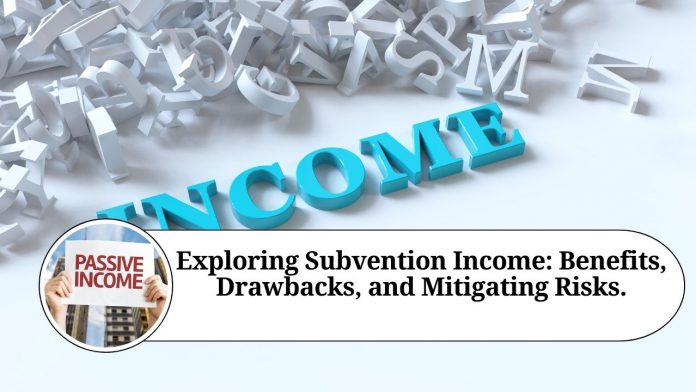Subvention income is a term used to describe a type of revenue that is generated through subsidies or grants. It refers to the funds received by an individual or organization from a third party, typically a government agency or a non-profit organization, to help support their activities or operations.
Subvention income can come in various forms, such as cash grants, tax incentives, subsidies, or other forms of financial assistance. The purpose of subvention income is usually to support specific projects or initiatives that are aligned with the goals of the funding organization. For example, a non-profit organization that works to promote environmental sustainability might receive subvention income from a government agency to fund research or advocacy efforts.
One of the advantages of subvention income is that it can provide stability to an organization’s finances, as it is often a reliable source of funding. However, subvention income can also have drawbacks. For example, if an organization becomes overly reliant on subvention income, it may struggle to find alternative sources of funding if the subvention income is reduced or discontinued.
In some cases, subvention income can also create conflicts of interest or lead to a perception of bias. For example, if a company receives subvention income from a government agency, there may be concerns that the company’s research or advocacy efforts are influenced by the interests of the funding organization.
Subvention income can be particularly beneficial for organizations that are working on social, environmental, or public health issues that may not be profitable in the traditional sense. For example, a non-profit organization that works to provide clean drinking water to communities in developing countries may not be able to generate revenue through sales or other traditional means, but may be able to receive subvention income from government agencies or philanthropic organizations that support such initiatives.
Subvention income can also be used to support research and development efforts, particularly in fields where the potential benefits may not be immediately apparent. For example, a start-up company that is developing new technologies for renewable energy may be able to receive subvention income from government agencies or private foundations that support research and innovation.
However, as mentioned earlier, subvention income can also have drawbacks. Organizations that rely heavily on subvention income may find themselves at risk if the funding is reduced or discontinued. This can lead to financial instability, as well as a potential loss of credibility and reputation.
To mitigate these risks, organizations should look for ways to diversify their sources of funding, so that they are not overly reliant on subvention income. This may involve seeking out grants or other forms of financial support from a variety of sources, including private foundations, corporate sponsors, and individual donors.
In addition, organizations should be transparent about their sources of funding and the potential conflicts of interest that may arise from subvention income. This can help to maintain trust with stakeholders and avoid any negative perceptions or allegations of impropriety.
Conclusion
In conclusion, subvention income can be a valuable source of funding for organizations that are working to achieve important goals, particularly in areas where traditional revenue streams may not be available. However, it is important for organizations to carefully consider the potential risks and benefits of subvention income, and to take steps to ensure that they are able to maintain financial stability and credibility over the long term.
Other Related Blogs: Section 144B Income Tax Act
Frequently Asked Questions (FAQs)
Q: What is subvention income?
A: Subvention income is a type of revenue that an individual or organization receives from a third party, typically a government agency or non-profit organization, to support their activities or operations. This can come in the form of cash grants, tax incentives, subsidies, or other financial assistance.
Q: How is subvention income different from regular income?
A: Subvention income is typically provided for a specific purpose, such as supporting a particular project or initiative. It is often non-recurring and may not be a reliable source of funding in the long term, whereas regular income is generated through the sale of goods or services and is typically more predictable.
Q: What are some examples of subvention income?
A: Examples of subvention income include grants provided by government agencies or non-profit organizations, tax incentives for businesses or individuals, subsidies for specific industries or activities, and financial assistance for research and development.
Q: What are the benefits of subvention income?
A: Subvention income can provide stability to an organization’s finances, as it is often a reliable source of funding for specific projects or initiatives. It can also help to support organizations that are working on important social, environmental, or public health issues that may not be profitable in the traditional sense.
Q: What are the drawbacks of subvention income?
A: Organizations that rely heavily on subvention income may be at risk if the funding is reduced or discontinued, leading to financial instability and potential loss of credibility. In addition, subvention income can create conflicts of interest or perceptions of bias, particularly if the funding organization has specific goals or interests.
Q: How can organizations mitigate the risks of subvention income?
A: Organizations can mitigate the risks of subvention income by diversifying their sources of funding and seeking out grants or financial support from a variety of sources. It is also important for organizations to be transparent about their sources of funding and potential conflicts of interest to maintain trust with stakeholders.




















